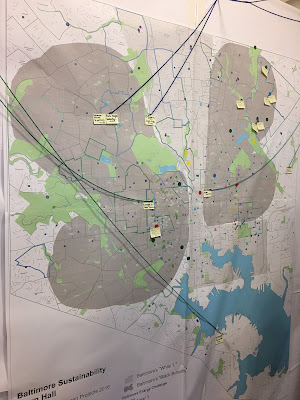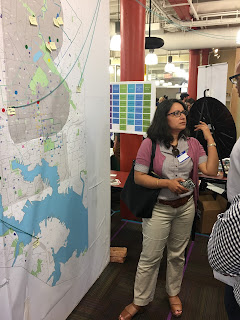 |
| Mark Cameron of DPW talks about dog poop disposal in front of a stormwater model (Photo: Philipsen) |
But public attention is fickle, sustainability as a buzzword was replaced by resilience and then faded into the background in favor of social justice and equity issues plaguing the City. None of these topics are in conflict with each other, only a sustainable city can be resilient and only a city with social justice can be sustainable or resilient.
Apparently lots of activists and citizens see it that way: on a beautiful spring evening they trekked in great numbers up the hill to the beautifully restored old brewery building which is now Humanim to attend the second "Town Hall" event conducted by the Office of Sustainability with the goal to conceive of a new plan. Humanim with its Details workforce re-entry training program for recycling building products through de-construction (instead of bulldozer demolition) is a wonderful example of the broad reach of sustainability.
But back to the Sustainability Plan:
Our current plan was adopted in 2009, and although it was an excellent plan for the time, much has changed on the ground and in our communities over the last six years. We need concrete metrics, a broader definition of what sustainability means, and greater attention paid to issues of equity and inclusion. (Office of Sustainability)The "Town Hall" at Humanim was more like a festival or sustainability fair than a traditional plan-update information event. It was also a class reunion for a broad diverse group of activists who all see themselves fit under the broad umbrella of sustainability. Tree Baltimore handed out free trees in front of the brewery building, there was complete "tiny house" open for visit, on the ground floor various groups presented their latest initiatives, including the electric bike of Baltimore's bike share program, Vacants to Value or the new MTA bus reform BaltimoreLink. Mark Cameron of the compliance division of Watershed Planning at the Department of Public Works entertained with the question on how to properly dispose of dog poop. If one lifted the cup with the right answer ("bag and dispose in trash") a Hershey kiss was the reward.
 |
| Tree giveaway by Tree Baltimore (Photo: Philipsen) |
On the second floor where the actual displays of the various sustainability plan topics were on display, crowds were dense. There was even a little cafe with green snacks and outdoor seating. Trash cans all had various recycle options; interactive opportunities for stickers, comments or suggestions existed everywhere, even inside the elevator.
Indicating the new focus on equity Baltimore's sustainability initiatives were displayed on a big map that emphasized the "White L and Black Butterfly" concept that has become a popular way of describing the "two Baltimores" in a compelling narrative which maybe too simple to really be productive. At least that is what BNIA leader Seema Iyer will not tire to explain, at the Town Hall in person and in front of the map.
Planning Director Stosur is very optimistic that his Green Infrastructure Plan will bring amenities even to deeply disinvested areas. The plan seeks to create more green and strategically place it based on demolition. Not everybody is on board with green as the economic development tool for the "black butterfly" areas. Community leader Arlene Fisher of Harlem Park vehemently stated in a conversation with Stosur that she doesn't need more green, that her neighborhood has parks and is green enough, that its problems are of another kind, certainly, she said, not the lack of green. An accurate observation, even when the Tree Baltimore map shows that the most disinvested parts of the city are also those with the least tree cover.
Our priority in this process and for the plan is equity. We want to make sure every story and every voice truly counts. We will focus on our most vulnerable, historically disinvested neighborhoods by leveraging new and existing initiatives and funding sources to help improve conditions where the most severe racial inequities exist. We will address the many facets of racial inequity across the city as well as class, disability, and age discrimination. (Office of Sustainability)
 |
| A map showing the White L and the Black Butterfly(Photo: Philipsen) |
"You don’t have to be a climate scientist or city planner to create sustainability + resilience. Everyone has a story to tell about making Baltimore a stronger, fairer and safer place for all of us. (website)The Office of Sustainability needs to continue to push innovation and enforcement. For example, the building code: Baltimore's Green Building Code was merged with the International Green Building Code. It is one of the most tangible efforts of making the city greener and less wasteful. The code requires more insulation, better appliances and generally higher energy efficiency and is an example of the complexity behind the sustainability effort. The code requires close collaboration with the Department of Housing which runs the building permits. To ensure code compliance, permit reviewers need to be trained in the energy code so they understand what they review. Developers need to see the benefits and learn how to comply without jacking up cost too much so that sustainability stays affordable.
 |
| The "Town Hall" with its display boards and exhibits was very well attended (Photo: Philipsen) |
The 2009 Sustainability Plan included 29 goals across seven core themes, maybe too much. Still, it would be good to begin a new plan with where the old plan ended. How successful was it?
The Office issued annual progress reports (the last one was done for 2015). The report is full of Success Stories and even has a data section. But like most city department reports, the data provide numbers for "tonnage collected from street sweeping", "Number of service calls for dirty streets", "city government energy usage" and the like, all data that do not really indicate progress towards specific goals since these raw data could be interpreted many ways. (More service calls could mean a dirtier city or more awareness, for example). There are some good news, average daily water usage has steadily declined, but given how inaccurate the meters have been, even this metric has a lot of question marks. A list of the tree canopy shows a growing number of trees in the city. But how are these numbers obtained and what do they mean? Everybody knows that the loss of a mature tree cannot be balanced with the planting of one of those new broom-stick trees that are put into sidewalks in great numbers only to die off after a year or two because not even minimum planting standards are maintained.
Progress seems to have been made in expanding healthy food choices into food deserts. But one of the sources, Baltimore's public markets, are in danger of slipping out from public control through private development and private management as you read this. In the transportation section bike-lane miles are counted; those, too, mean little if they are not maintained and regularly re-striped. The actual metrics, what is the mode-share of bicycles today and what is the target are not reported. Nor are bike and pedestrian fatalities. Other transportation metrics such as Circulator and MTA ridership are already falling leading up to 2015 and probably have fallen even further since then. Here too, the mode share is what matters, not the absolute number of riders, since it needs to be adjusted for population and employment.
 |
| From the 2015 Sustainability Report. |
The new Sustainability Plan should focus on how a shorter list of less open-ended metrics can be defined which includes realistic targets. It, like all other City Plans, should be monitored by a revamped CitiStat that provides impartial data driven reports. It still remains to be seen what the Pugh administration will do with CitiStat.
The Office of Sustainability's focus on equity is understandable, but it could easily become an excuse fore even fewer hard data.
Poor residents would benefit the most from a greener, more effective government and more environmentally friendly apartments and buildings, but only if its real and not just talk.
 |
| Philadephia 2015 progress report (Overview Chart) |
Klaus Philipsen, FAIA
See also on this blog: Sustainability Plan 2.0
 |
| Sustainability Commissioner Peter Doo studies a display (Photo Philipsen) |
Process Timeline for the new plan:
April – Ambassador Recruitment
May – Ambassador Recruitment and Trainings
June-August – Ambassador outreach and information gathering
September-November – Community meetings and feedback on plan
December – Plan adoption
 |
| BNIA's Seema Iyer argues that the White L is too simplistic (Photo Philipsen) |
 |
| New Baltimore Delegate Robbyn Lewis poses with the Green Frog. (Photo Philipsen) |
Hello I am so happy I found your blog page, I really
ReplyDeletefound you by error, while I was researching on Aol for something else,
Anyways I am here now and would just like to say many
thanks for a fantastic post and a all round interesting blog (I also love the theme/design), I
don’t have time to look over it all at the moment but I have bookmarked it and also added your RSS feeds,
so when I have time I will be back to read a great deal more,
Please do keep up the awesome b.